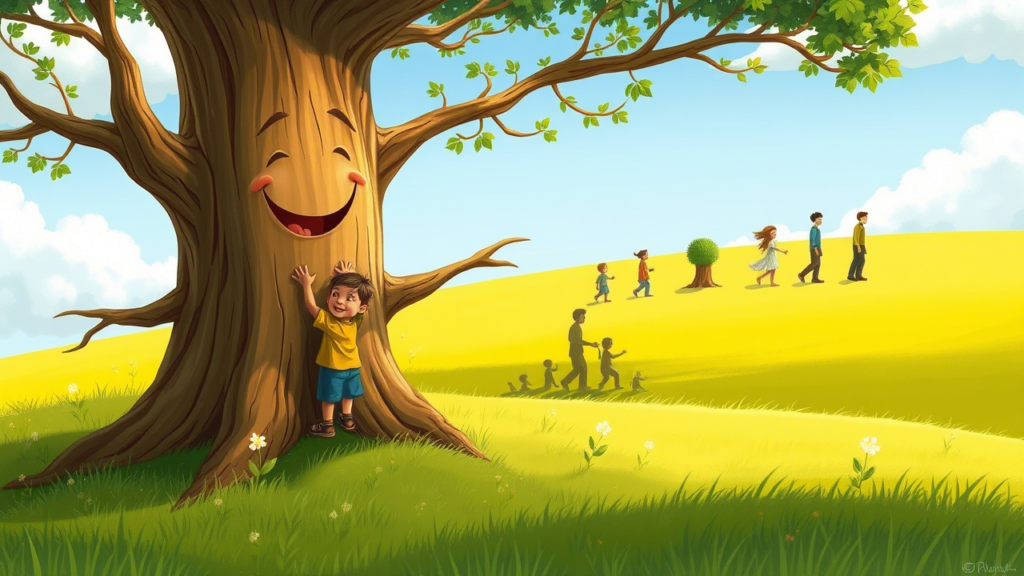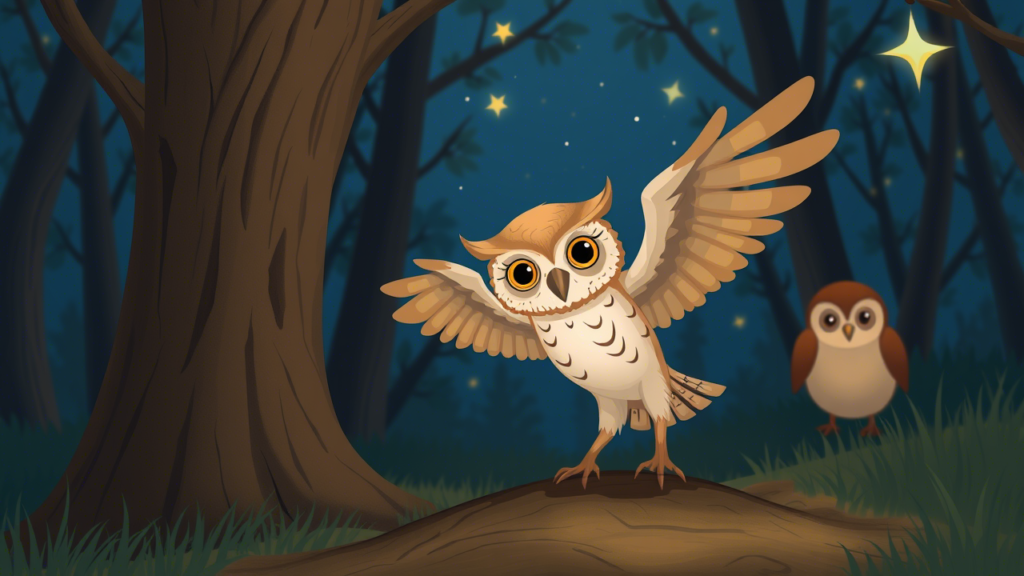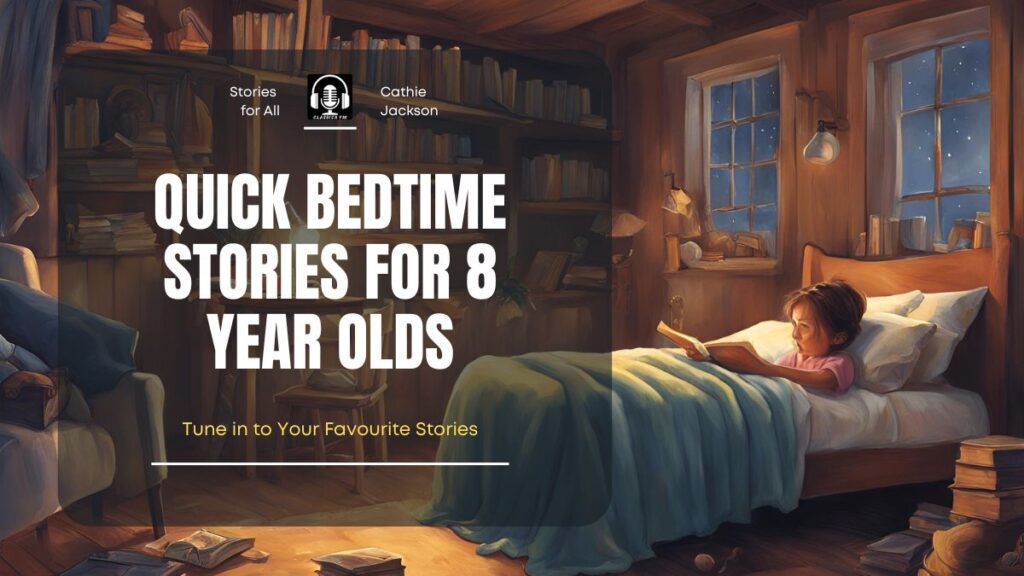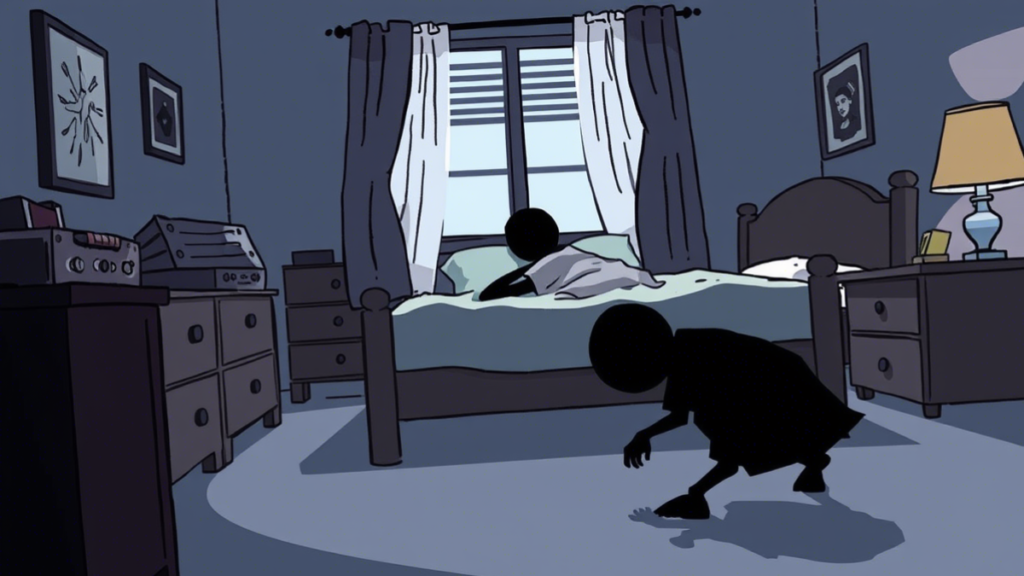Many of us have trouble falling asleep because we’re stressed, anxious, or have spent too much time on screens. It’s tough to quiet the mind. But bedtime stories can help! Listening to a calming story can take your mind off your worries and help you relax.
More adults are turning to bedtime stories to unwind before bed. They find it’s a simple, soothing way to end the day. If you’re looking for a peaceful way to fall asleep, here are bedtime stories for adults to help you relax and drift off into sleep.
The Science Behind Bedtime Stories and Sleep
Ever wondered why bedtime stories make falling asleep so much easier? Discover the science behind how stories can help calm your mind and improve your sleep quality.
How Stories Help?
- Stories help you forget about stress and relax.
- They lower your stress, making it easier to unwind.
- They get your body ready for sleep.
Brain Impact
- Stories shift your mind from worries to calm thoughts.
- They help clear your head and feel peaceful.
- This makes falling asleep easier.
Calming Response
- Stories help your body relax.
- They make you feel safe and cozy, helping you sleep.
- They get your body ready to rest.
Research
- Studies show stories help you sleep better.
- They boost melatonin, which helps you sleep.
- Regular bedtime stories can improve your sleep overall.
Bedtime Stories for Adults to Fall Asleep
Struggling to fall asleep? Bedtime stories for adults could be the perfect solution! Discover how a calming story can help you relax and drift off to sleep.
The Giving Tree by Shel Silverstein: A Journey of Selflessness and Love

The Giving Tree by Shel Silverstein is one of those timeless stories that has touched the hearts of readers of all ages. The beauty of this story is that, at its core, it’s simple, yet it holds powerful meanings about love, sacrifice, and the passage of time. The story is about a tree and a boy who share a lifelong relationship. Over the years, the boy grows older, and his needs and desires change, while the tree continues to give without asking for anything in return.
This book has always been popular because it talks about love in such an uncomplicated way. The tree doesn’t expect anything from the boy—she only wants to see him happy. But as time passes, we see how much giving can sometimes hurt, and how love changes over the years. The simplicity of Silverstein’s writing draws you in, but it’s the deeper themes of love and sacrifice that make it so memorable.
The Beginning: A Joyful Friendship
The story begins with a young boy and a tree who are best friends. The boy spends his days playing in the tree’s branches, eating her apples, and enjoying the shade she offers. The tree is happy just seeing the boy enjoy himself. She’s content in the simple act of giving him what she has. It doesn’t matter that all she has to offer is her apples and branches; the boy’s happiness is all the tree needs to feel complete.
At this point in their relationship, there are no strings attached. The boy asks for something, and the tree gives it to him. This part of the story is filled with innocence and simplicity. It’s easy to see why so many people connect with this section of the story, because it represents a time in life when things are easy, carefree, and full of joy. The boy and the tree are simply enjoying each other’s company, and life seems uncomplicated.
This is the essence of unconditional love—the willingness to give, just for the sake of the other person’s happiness. The tree asks for nothing in return. She is fulfilled by the boy’s joy, and the boy is happy because he has everything he needs. This phase of their relationship is about innocence and sharing what you have, whether it’s a simple apple or a moment of play.
The Boy Grows: The Shift Toward Material Needs
As time goes on, the boy starts to grow older, and with age comes new desires. He no longer comes to the tree just to play and relax. Now, he wants more than the apples or the shade the tree provides. He begins to seek out material things—money, a house, and the comforts of adult life.
One day, the boy asks the tree for money. The tree, being a tree, doesn’t have money, but she offers her apples, hoping the boy can sell them for the money he needs. She gives him her apples, and the boy leaves, taking them to sell. This is the first real sign of change in their relationship. The boy is no longer content with simple pleasures; he is searching for something bigger, something that will help him build his life. The tree, in turn, gives what she has in order to help him.
This part of the story reflects how, as we grow older, our needs and wants change. When we’re young, the world feels simpler. But as we get older, we start seeking things that promise to give us more security, status, or comfort. The boy, now focused on his adult needs, no longer finds joy in the small, simple things the tree once offered. This marks the beginning of the tree’s greater sacrifices for the boy, even though he doesn’t ask for them in quite the same innocent way anymore.
The Teenage Years: A Deepening Desire for More
As the boy grows into a young man, his needs continue to shift. The material wealth he once sought no longer satisfies him. Now, he asks the tree for something even bigger—wood to build a house. The tree, though she has already given away her apples, offers her branches to the boy. She hopes that this will help him create a home, a place where he can settle and find happiness.
This is the second major sacrifice the tree makes. The tree’s once full branches are now gone, and she gives them up because she believes it will make the boy happy. But with this sacrifice, we begin to see a shift in the balance of the relationship. The boy is taking more, and the tree is giving everything she has, all in the hope of fulfilling his needs.
The story here begins to highlight the deeper emotional costs of giving. The tree is happy to give, but it’s clear that the more she gives, the less she has for herself. In real life, this is something we all can relate to—sometimes, in relationships, we find ourselves giving and giving without expecting anything in return, hoping that it will make the other person happy. But as the tree’s sacrifices increase, it’s hard to ignore the emotional toll that constant giving can take.
The Adult Years: The Ultimate Sacrifice
As the years go by, the boy, now a full-grown man, comes back to the tree. He’s no longer looking for simple things like apples or branches. Instead, he asks the tree for her trunk, so that he can build a boat. The tree, now reduced to a stump, gives him her trunk without hesitation, hoping that it will give the boy what he needs to be happy.
This is the most significant sacrifice the tree makes. She no longer has any apples or branches to offer. Her trunk is all she has left, and she gives it to the boy without asking anything in return. The boy takes the trunk, builds his boat, and leaves the tree behind, now focused solely on his own journey.
This part of the story is where the themes of sacrifice and giving without receiving come into sharp focus. The tree gives up the last piece of herself, hoping it will bring happiness to the boy. But as we read this, we can’t help but wonder—what happens when one side of a relationship gives everything, but the other side takes without giving anything back? This is the emotional cost of love: the tree’s sacrifices leave her with nothing, while the boy continues on his path without looking back.
The End: A Moment of Peace
Years later, the boy, now an elderly man, returns to the tree. He’s tired, worn out, and no longer seeking anything material. He just wants a place to rest. The tree, though reduced to a stump, is overjoyed to offer him this small comfort.
At this moment, the boy and the tree find peace in each other’s company. The boy, no longer seeking wealth or status, simply needs a place to rest. The tree, now a stump, offers him the only thing she has left: a space to sit. The boy sits, and the two share a quiet, peaceful moment together.
This is where the story ends, and it’s a quiet, serene conclusion. After all the sacrifices, all the giving and taking, the boy and the tree find contentment in each other’s presence. There is no more giving, no more taking. Just a moment of peace and companionship.
Themes of Love, Sacrifice, and Selflessness
At the heart of The Giving Tree is a story of love and sacrifice. The tree’s love for the boy is unconditional and pure. She gives everything she has, time and time again, because she believes it will bring him happiness. But the story also asks us to think about the emotional costs of such selflessness. Is it healthy to give everything without receiving anything in return? Can love thrive in such an unequal relationship?
The story reminds us that love is beautiful when it’s given freely, but it’s also important to recognize the need for balance in relationships. Love should be mutual, and both parties should care for one another. The tree’s sacrifices, while admirable, also show us that constant giving without any return can leave us with nothing.
Conclusion: A Timeless Tale of Giving and Love
The Giving Tree is a timeless story that touches on universal themes of love, sacrifice, and the passage of time. The tree’s endless giving and the boy’s changing needs create a powerful narrative about the complexities of relationships. The tree’s love for the boy never wavers, even as she gives more and more of herself. And in the end, when the boy finally returns as an older man, the two find peace in their quiet connection.
This story reminds us that love, at its purest, is about giving and receiving. But it also teaches us the importance of balance and the emotional toll that sacrifice can have. Shel Silverstein’s The Giving Tree continues to resonate with readers because of its simplicity and the depth of its meaning. It’s a story we can all relate to, no matter how old we are.
The Star and the Moon: A Tale of Friendship and Finding Your Place

Once upon a time, in a world where the sky was endless and full of wonder, there lived a star named Luma. Luma was bright, small, and always twinkling in the night sky. While she was surrounded by many other stars, Luma often felt a little out of place. She wasn’t the biggest star, and sometimes she wondered why she couldn’t shine like the others. She longed for a sense of purpose, for something more than just twinkling away in the darkness.
But Luma wasn’t alone. Far across the sky, there was a gentle moon named Mira. Mira was calm, kind, and always watching over the world below. She was much larger than Luma and always shone with a steady, soothing light. Unlike Luma, Mira was never unsure of herself. She knew exactly where her place was in the sky, and she always felt like she was doing something important.
One evening, as the stars began to appear in the sky, Luma found herself gazing at Mira, wondering what it would be like to shine with such confidence. “How do you do it, Mira?” Luma asked shyly. “How do you know exactly where you belong?”
Mira smiled warmly. “It took time, little star,” she said gently. “But it’s about finding your own light and learning to trust it.”
The Early Days: Learning to Shine
At first, Luma didn’t understand what Mira meant. What did it even mean to “find your own light”? All Luma knew was that she wanted to be noticed, to shine brighter, to be important. She had so many dreams of lighting up the night sky, but she wasn’t sure how to begin.
The next night, when the sky was dark and full of stars, Luma tried harder than ever to shine. She twinkled and flickered as brightly as she could, but it still felt like something was missing. She wasn’t as big or as steady as the other stars. No one seemed to notice her.
Mira watched from a distance, knowing Luma’s struggle. After a while, she floated closer to Luma and spoke softly. “You don’t have to try so hard, little one. Just be yourself. The sky will see your light in its own time.”
Luma looked up at Mira, still uncertain. “But how do I do that? I want to be noticed. I want to shine brighter, just like you.”
Mira paused and thought for a moment. “When I first rose into the sky, I didn’t always know where I fit either. But with time, I learned that it wasn’t about being the brightest or the biggest. It was about being steady, being there for the world below, and trusting that the right people would see me for what I was.”
Luma listened closely. Could it be that she didn’t need to be the biggest or brightest to matter?
The First Test: The Darkest Night
One night, the sky grew darker than ever before. A storm was coming, and the clouds covered the sky completely. The other stars blinked nervously, unsure of how they would shine through the thick clouds. Luma felt a little scared too, but something inside her told her to keep going.
Mira, the moon, had seen storms before, and she knew that this one would pass. Still, she wanted to help the little star. “Luma,” Mira called out through the storm, “It’s time to show the world your light. Don’t be afraid. Even in the darkest times, your light is important.”
Luma trembled a little but nodded. She took a deep breath and started to twinkle as best as she could. It wasn’t as bright as the stormy sky or as strong as the winds around her, but it was enough. Slowly, the clouds parted just enough for Luma to shine through.
To Luma’s surprise, the world below noticed. There was a traveler lost in the forest, a small child trying to find her way home, and a family looking up at the night sky. They all looked up at the faint twinkle that cut through the dark, and it gave them hope.
Mira smiled from afar. “See, Luma?” she said softly. “Your light made a difference, even when you didn’t think it would.”
The Lesson of Patience: Finding the Right Time
The weeks passed, and Luma continued to twinkle in the night sky. Sometimes she would shine brightly, and other times, she would flicker softly in the distance. But every night, she would shine in her own way.
Mira, who had seen many moons rise and set, knew the importance of patience. She knew that every star, no matter how big or small, had its own purpose. Luma was beginning to understand this too. She no longer felt the need to compete with the other stars or try to shine like Mira. She was learning to appreciate her own glow and realized that her light was just as valuable as the others.
One quiet evening, when the sky was clear and filled with stars, Luma had an idea. “Mira,” she said, “What if I tried to make my light a little steadier, like yours?”
Mira thought for a moment. “Being steady is important, but you must also allow your light to change. Sometimes, it’s okay to flicker and twinkle. Sometimes, it’s okay to shine brightly. Just be true to yourself and your own light.”
Luma nodded, grateful for Mira’s wisdom. She realized that her purpose wasn’t to be like anyone else, but to embrace her own way of shining. Sometimes, that meant being bright and bold, and other times, it meant simply twinkling softly in the distance.
The Final Test: Helping Others in Need
One day, the sky grew cloudy once again. A deep fog settled over the land below, and the people below couldn’t see the way forward. Luma watched with concern as she saw a group of travelers trying to find their way. They were lost and unsure of which path to take.
Mira, ever calm and steady, shone her light over the world, providing guidance to the travelers. But she noticed that Luma, in all her smallness, could offer something that she couldn’t. “Luma,” she called softly, “This is your chance. Show them the way.”
Luma’s heart raced, but she knew this was her moment. She flickered brightly, reaching down through the fog, cutting through the mist with her little glow. It wasn’t the brightest light in the sky, but it was enough to guide the travelers. Slowly, they followed her light, finding their way through the fog and back onto the path.
When the fog finally lifted and the sky cleared, the travelers looked up at Luma, their faces filled with gratitude. They hadn’t noticed the other stars, nor had they seen the moon’s steady light. It was Luma’s twinkle that had led them through the dark.
Mira watched from afar, smiling. “See, Luma? You found your place in the world. Your light may be small, but it’s always needed.”
The True Meaning of Light: Embracing Your Own Way
From that night on, Luma no longer worried about being the biggest or the brightest. She understood now that every star, no matter how small, had a unique role to play in the sky. Her light didn’t have to be constant or perfect. It just had to be true.
As time passed, Luma continued to shine in her own special way. Some nights, she would twinkle and flicker, and other nights, she would shine bright and steady. And every time, she remembered the lesson Mira had taught her: “Just be yourself, and trust your light. The world will see you when the time is right.”
Mira, the steady moon, watched over her friend with pride. She knew that Luma had found her place in the vast, endless sky. No longer did she doubt herself or wonder if she was enough. She was exactly who she was meant to be—a small star with a big heart, shining her light for those who needed it.
And so, Luma twinkled brightly in the night sky, knowing that no matter how small she might seem, her light was needed and valued. She had found her place in the world, and that was enough.
Conclusion: A Lesson in Trust and Patience
The Star and the Moon is a story about finding your place in the world and trusting that, no matter how small or uncertain you feel, your light will shine when the time is right. It’s a reminder that sometimes, we don’t have to be the biggest or the brightest to make a difference. All we need is to be true to ourselves and trust that our light is important.
Just like Luma, we all have our own unique way of shining, and we don’t have to compare ourselves to others. Whether we flicker softly or shine boldly, we are enough. This story encourages us to embrace who we are, find our own way, and trust that the world will see us when we least expect it.
The Tale of The Little Owl Who Learned to Fly

In a quiet forest nestled between two rolling hills, there lived a small owl named Ollie. Ollie wasn’t like the other owls in the forest. While his friends hooted joyfully from the treetops, soaring through the air with ease, Ollie preferred to stay grounded. He had tiny wings, and even though he tried to fly every day, something always seemed to hold him back.
The other owls would fly high in the sky, their wings strong and steady, but Ollie just couldn’t seem to get off the ground. He would flap his wings as fast as he could, but no matter how hard he tried, he only managed to hop a little higher, then tumble back down.
“Why can’t I fly like the others?” Ollie would ask himself as he watched his friends glide through the trees, high above.
One day, after watching his friends fly into the sunset, Ollie felt a wave of sadness wash over him. He wished he could be as free as they were. But every time he tried, his wings felt too small, and the ground beneath him felt safer.
The Wise Old Owl: Seeking Answers
Ollie’s curiosity eventually led him to the oldest and wisest owl in the forest, a majestic owl named Orion. Orion had lived many years, and he had seen countless generations of owls come and go. He was known for his wisdom, and many animals in the forest came to him with questions.
One day, feeling a little unsure of himself, Ollie flew—well, more like hopped—up to Orion’s perch.
“Orion,” Ollie began, his voice tinged with uncertainty, “I’ve been trying to fly for so long, but it just doesn’t seem to work. What am I doing wrong?”
Orion looked at Ollie with kind eyes and smiled softly. “Ah, young one, you’re not doing anything wrong. You simply haven’t found your own way yet.”
Ollie tilted his head. “My own way?”
“Yes,” Orion continued, “Every owl has their own journey, Ollie. Some learn to fly early, while others take a bit more time. Your wings may feel small, but they are strong. You simply need to trust in them and believe that one day, you will soar.”
“But I’ve tried everything! What if I never learn to fly?” Ollie asked, his voice filled with doubt.
Orion chuckled softly. “You won’t know unless you keep trying. Patience is the key, Ollie. The sky is waiting for you, and you just need to be ready.”
The Struggle: Learning to Trust
The next day, Ollie decided to try again. He flew—well, he hopped—up onto the highest branch of the tallest tree. His wings fluttered, and his heart raced with excitement, but as usual, he fell right back down to the ground.
“Maybe Orion was wrong,” Ollie thought, feeling discouraged. “Maybe I’m just not meant to fly.”
But as he sat on the ground, staring up at the sky, something caught his eye. A butterfly floated by, its delicate wings barely flapping. Ollie watched in awe as the butterfly glided from flower to flower, so graceful and free. “How does it do that?” Ollie wondered.
Then, Ollie remembered something Orion had told him: “Trust in your wings. They are strong.”
For the first time, Ollie decided to take a deep breath and focus. He began to flap his wings slowly, gently, as if he was learning to dance. He stopped worrying about how high he could go or how fast. Instead, he listened to the rhythm of his wings and felt the air around him. For a moment, it felt as though the world had paused, and Ollie was simply part of the breeze.
But something unexpected happened. Ollie didn’t fall. Instead, he fluttered, just for a moment, and then—he was soaring.
The First Flight: A Moment of Triumph
Ollie felt the air beneath his wings and the wind in his feathers. His wings, small as they were, were holding him up. His heart pounded with excitement as he hovered above the ground, and for the first time, he didn’t feel scared. He felt free.
For a few seconds, Ollie flew in circles, higher and higher, until he finally landed softly on a branch. His eyes were wide with disbelief. “I did it,” he whispered, barely able to contain his joy. “I really did it!”
The sun was setting, and the forest was beginning to glow with the warm hues of twilight. Ollie looked around at the trees, now from above. Everything seemed so different from up here.
Suddenly, he heard a familiar voice.
“Well done, Ollie,” Orion said, perched on a nearby branch with a proud smile.
“I can’t believe it! I actually flew!” Ollie exclaimed.
“You did,” Orion agreed. “And you’ll continue to do so, as long as you trust yourself and believe in your wings.”
Ollie’s chest swelled with pride. “I guess I just needed to trust, didn’t I?”
“Exactly,” Orion said. “Trust in yourself, Ollie. Trust in your journey. Your wings may have seemed small at first, but they are just right for you.”
The Newfound Confidence: Embracing the Sky
From that day on, Ollie practiced flying every day. At first, it was just a few fluttering hops, but each time, his wings felt stronger. His confidence grew with each attempt. He would soar through the trees, his wings steady and strong, and every night he would rest under the stars, feeling a sense of accomplishment.
Soon, Ollie began to teach the younger owls how to fly. He would watch them with patience, just as Orion had watched him, and he would remind them that every owl’s journey was different. Some would fly easily, while others would need a little more time. But in the end, they would all find their wings, just like Ollie had.
One night, Ollie sat with Orion, gazing at the stars above. “I feel so different now,” Ollie said, his voice full of wonder. “I never thought I’d be able to fly like the others, but now I know that my wings were always enough.”
Orion nodded. “You’ve learned the most important lesson of all, Ollie. It’s not about how fast or far you fly. It’s about trusting the journey and knowing that, in time, you will reach the heights you are meant to.”
Ollie smiled and looked up at the sky, feeling more at peace than ever before. He had found his place in the world, and his wings had taken him farther than he had ever imagined.
The Final Flight: A New Beginning
As time passed, Ollie became known as one of the wisest owls in the forest. He no longer worried about how he compared to others. He had learned that his wings were perfect just the way they were. He could soar through the trees, fly high into the sky, and glide through the cool night air.
But more importantly, Ollie had learned that life was about more than just flying. It was about believing in yourself, trusting the journey, and knowing that, no matter how long it took, every owl would eventually find their wings.
One evening, as Ollie soared through the sky, he spotted a little owl at the edge of the forest, looking up at the stars.
“Are you lost?” Ollie asked, flying down beside the young owl.
The little owl looked up with wide eyes. “I want to fly, but I’m not sure how.”
Ollie smiled and gently perched beside the young owl. “Don’t worry, little one,” he said softly. “I’ll help you find your wings, just like someone once helped me.”
And with that, Ollie began to teach the little owl how to trust in their wings, knowing that every owl’s journey was unique and that, in time, they would all learn to soar.
Conclusion: The Endless Sky
And so, Ollie continued to fly through the skies of the forest, sharing his wisdom and his journey with others. The sky stretched endlessly above, filled with stars, and Ollie knew that no matter how many owls came and went, they would all find their place in the world, just like he had.
As the wind gently rustled through the leaves, Ollie’s wings carried him higher and higher, and the forest below looked peaceful and calm. Ollie had found his wings, and in doing so, he had found himself.
Why Adults Need Bedtime Stories Too
Bedtime stories aren’t just for kids! Find out why adults can also benefit from a good story before bed to relax and sleep better.
Stress and Anxiety Relief
- Offers a calming break from daily worries
- Helps reduce tension and promotes relaxation
Nostalgia and Comfort
- Brings back comforting childhood memories
- Reconnects with soothing bedtime routines
Mental Distraction
- Helps quiet racing thoughts
- Prepares the mind for rest by focusing on the story
Digital Detox
- Provides a break from screen time
- Encourages melatonin production for better sleep
The Benefits of Bedtime Stories for Adults
Bedtime stories aren’t just for kids—they can help adults relax too! Discover how a good story before bed can help you sleep better and unwind after a busy day.
Stress Relief
- Provides a gentle escape from daily stress
- Helps promote relaxation before sleep
Mental Relaxation
- Shifts focus away from racing thoughts
- Calms the mind for a peaceful transition to sleep
Improved Sleep Quality
- Prepares the mind for restful sleep
- Encourages natural melatonin production
Digital Detox
- Offers a break from screens and technology
- Reduces blue light exposure before bedtime
Emotional Comfort
- Reconnects you with comforting childhood memories
- Evokes a sense of security and nostalgia
Enhanced Creativity
- Sparks the imagination with engaging narratives
- Inspires creative thinking and mindfulness
How to Choose the Right Bedtime Story?
Struggling to pick the right bedtime story? Choosing the perfect one can help your child relax and sleep better. Let’s explore how to find the best story for a calm, cozy night!
Consider Your Mood
- Choose stories that match how you’re feeling
- Pick calming, soothing tales for relaxation or lighthearted ones for a happier mood
Focus on Length
- Opt for short stories if you’re looking for a quick wind-down
- Choose longer stories if you prefer a more immersive experience before sleep
Pick Positive or Peaceful Themes
- Avoid intense or overly stimulating stories
- Choose tales with calming, peaceful themes like nature or kindness
Avoid Complex Plots
- Go for stories with simple plots to prevent mental overstimulation
- Look for narratives that flow easily without requiring too much mental effort
Personal Interests
- Select stories based on your interests, whether that’s fantasy, adventure, or personal growth
- Familiar themes can be more comforting and help you feel more at ease
Look for Familiarity
- Revisit old favorites to evoke feelings of comfort
- Familiar stories can make bedtime feel more relaxing and cozy
How to Incorporate Bedtime Stories into Your Routine?
Want an easy way to end your day? Bedtime stories could be the perfect choice! In this guide, we’ll share how you can easily add stories to your nightly routine. Ready to make bedtime special? Let’s dive in!
Set a Consistent Time
- Choose a regular time each night to wind down
- Create a routine to signal your body that it’s time to relax
Create a Calm Environment
- Dim the lights and make your space cozy
- Consider adding soft music or a candle for extra relaxation
Choose Your Story Ahead of Time
- Select your bedtime story earlier in the evening to avoid rushing
- Keep a list of favorites to easily pick from when it’s time
Limit Distractions
- Turn off your phone or other electronics before starting your story
- Create a quiet, peaceful space with minimal interruptions
Involve a Partner or Family
- Share stories with your partner, kids, or loved ones
- Take turns reading or listening together for a more enjoyable experience
Use Audiobooks or Apps
- If you’re too tired to read, try using audiobook apps or story podcasts
- Listen to soothing narrations to help guide you into relaxation
End with Relaxation
- Once the story ends, give yourself a few minutes of quiet reflection
- Focus on your breathing or listen to calming sounds to ease into sleep
Overcoming Common Challenges
Everyone faces challenges, but with the right mindset and tools, you can turn obstacles into opportunities. Let’s explore how to tackle life’s hurdles and come out stronger.
Difficulty Focusing
- Choose shorter, simpler stories if your mind tends to wander
- Start with a calming environment to help your brain focus on the story
- Try audiobooks if reading feels too distracting
Too Much Mental Clutter
- Practice mindfulness before starting the story to clear your thoughts
- Consider light stretching or deep breathing to help relax your mind
- Choose familiar, comforting stories to ease anxiety
Lack of Time
- Pick shorter stories that fit into your schedule
- Set aside just 10-15 minutes to enjoy a quick escape
- Make bedtime stories a part of your evening wind-down routine
Finding the Right Story
- Keep a list of your favorite stories handy to easily choose each night
- Try different genres until you find what works best for you
- Experiment with storytelling apps or audiobooks for new options
Getting Distracted by Technology
- Limit screen time and set your devices to “do not disturb” mode
- Read physical books or listen to stories offline to avoid distractions
- Create a designated bedtime space free from tech distractions
Staying Consistent
- Set a reminder or make it part of your nightly routine
- Make it a relaxing, enjoyable habit to look forward to each night
- Start small and gradually incorporate bedtime stories into your routine
Conclusion: Rediscovering the Joy of Sleep Through Stories
Bedtime stories aren’t just for kids—they can work wonders for adults too! Listening to a story before bed helps you relax, ease stress, and calm your mind after a busy day.
You can try different kinds of stories, like short tales, peaceful meditations, or even soothing podcasts. The trick is to find something that makes you feel at ease and ready for sleep.
So why not give a bedtime story a try tonight? It might be a small change, but it could make a big difference in how well you rest.
Mark Richards is the creative mind behind Classica FM, a podcast platform that brings stories, knowledge, and inspiration to listeners of all ages. With a passion for storytelling and a love for diverse topics, he curates engaging content—from kids’ tales to thought-provoking discussions for young adults.



